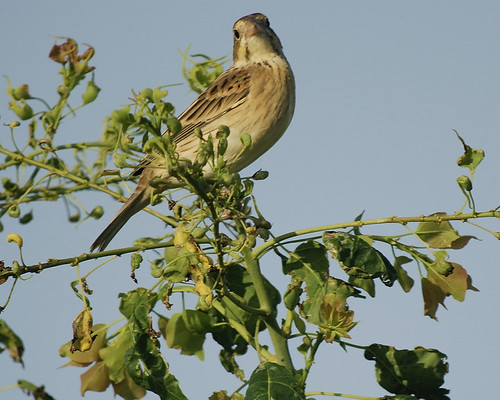tags: Dickcissel, Spiza americana, birds, mystery bird, bird ID quiz
[Mystery bird] Dickcissel, Spiza americana, photographed at Eisenhower Park, Houston, Texas. [I will identify this bird for you tomorrow]
Image: Joseph Kennedy, 25 August 2007 [larger view].
Nikon D200, Kowa 883 telescope TSN-PZ camera eyepiece 1/320s f/8.0 at 1000.0mm iso400.
Please name at least one field mark that supports your identification.
Rick Wright, Managing Director of WINGS Birding Tours Worldwide, writes:
Wow, does that ever look like a House Sparrow! But wait, the tail is a bit too long, the breast a bit too heavily streaked, the bill a bit too "mean," and the lateral throat stripe a bit too strong. This is a female Dickcissel, identified by the same structural characters that seem almost redundant on the colorful breeding male. It's well worth learning this duller plumage, as these are the birds that appear in fall and winter outside of the species' breeding range among flocks of House Sparrows and emberizids.
- Log in to post comments


Hm. This is tricky.
There's a hint of "pipit" in this bird's posture (which I guess I'm getting from the upward-tilted bill), and with the bill straight on to the camera it's hard to tell if that's a pointy pipit beak or a chunky sparrow beak.
If it's not a pipit, then I'm thinking it's one of the Ammodramus sparrows.
The problem I'm having is that no matter what bird I pick, Sibley calls out things that aren't particularly evident in this bird. If this is a Sprague's Pipit, then where are its white wingbars? And why does this bird have a lateral throat stripe? If this is a Baird's Sparrow, why is the streaking on its breast so pale and minimal? If this is a Le Conte's sparrow, why don't I see the white median crown-stripe? Maybe a Henslow's Sparrow? It might come closest of any of its genus-mates. But for all these sparrows, why is this bird's head so small relative to its body? Man, I could sure use a side view of that bill right now.
Maybe an immature Spizella sparrow? Clay-colored and Chipping both seem like possibilities. No; I think this bird's tail is too short for them.
Hm. You know what? I'm going to reject all of them, and go with something completely different: a first-winter female Dickcissel. It doesn't quite match the Sibley illustration, but it probably comes closer than any of the other choices I've been looking at.
John's right - I've seen plenty of Dickcissels, and this is one of those. Hatch-year Spiza americana. The hint of creamy-yellow in the broad mustache-stripe could mean that this is a male, but you won't really know until the next spring.
first year male dicksissel. Tail is medium length. primary tip projection fairly long. General shape shows a slimness/sleekness not to be confused with any of the emberizine family. bill appears nicely concial and symmetrical. while the median coverts do not have the extent of tinges of future rufous ( more female looking), the malar and breast color are 'brighter' than I would anticiapte for female.